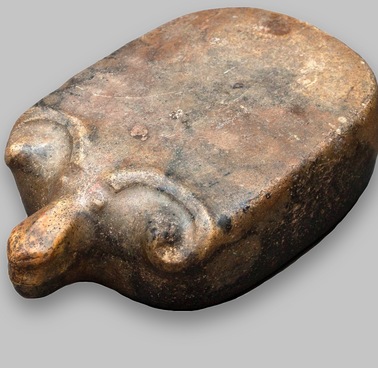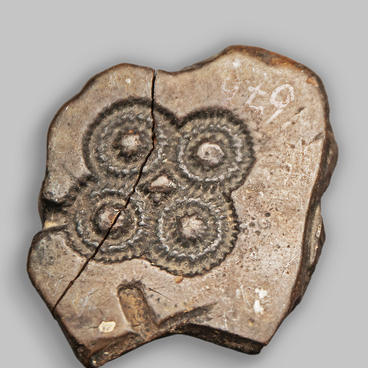The decorative faience vase, among many artistic treasures, was transferred to Tobolsk from the State Museum Fund in 1920. It was supposed to be part of the collection of the Museum of Fine Arts organized by the artist Panteleymon Chukomin. After the institution was closed, the vase was transferred to the Museum of the Tobolsk North, now the Tobolsk Historical and Architectural Museum-Reserve.
The vase is made in the majolica technique. It is a type of ceramic that was made from colored baked clay and decorated with opaque painted glaze. On the entire surface, the master made a relief drawing representing yellow leaves with brown edging. The rest of the surface was decorated with a background in the form of mother-of-pearl bluish-green streaks with brown flecks. At the bottom of the vase, there is a stamped inscription ‘Abramtsevo’. This means that it was made in the Abramtsevo Ceramic Workshop, which belonged to the industrialist and philanthropist Savva Mamontov.
In 1870, Mamontov bought the estate from the famous writer Sergey Aksakov. It was often visited by artists from the ‘mammoth circle’, an unofficial art association. In 1889, on the initiative of Elena Polenova, an experimental workshop was created at the estate to revive the hand-made pottery, and in particular Russian majolica. Many artists tried their hand at this, but the greatest contribution to the development of majolica production was made by Mikhail Vrubel and Pyotr Vaulin.
Vrubel who has already been an established artist of the turn of the 19th - 20th centuries worked in almost all types and genres of fine art, such as painting, graphics, and decorative sculpture. Twenty-year-old Ural resident Vaulin was an unknown ceramic artist and chemical technologist, a graduate of the Krasnoufimsk Agricultural School. He was invited to lead workshops in Abramtsevo. Together, Vrubel and Vaulin were able to rediscover the lost method of recovery firing, in which the glaze received an iridescent sheen and became like metal. The translucent coating had shades of gold, silver, and copper.
The Abramtsevo majolica became a monument of the Art Nouveau era. It took pride of place at Russian and international exhibitions. At the World Exhibition in Paris in 1900, Savva Mamontov was awarded a gold medal as a manufacturer of majolica products, and Mikhail Vrubel received a gold medal for majolica works as an artist.
The vase is made in the majolica technique. It is a type of ceramic that was made from colored baked clay and decorated with opaque painted glaze. On the entire surface, the master made a relief drawing representing yellow leaves with brown edging. The rest of the surface was decorated with a background in the form of mother-of-pearl bluish-green streaks with brown flecks. At the bottom of the vase, there is a stamped inscription ‘Abramtsevo’. This means that it was made in the Abramtsevo Ceramic Workshop, which belonged to the industrialist and philanthropist Savva Mamontov.
In 1870, Mamontov bought the estate from the famous writer Sergey Aksakov. It was often visited by artists from the ‘mammoth circle’, an unofficial art association. In 1889, on the initiative of Elena Polenova, an experimental workshop was created at the estate to revive the hand-made pottery, and in particular Russian majolica. Many artists tried their hand at this, but the greatest contribution to the development of majolica production was made by Mikhail Vrubel and Pyotr Vaulin.
Vrubel who has already been an established artist of the turn of the 19th - 20th centuries worked in almost all types and genres of fine art, such as painting, graphics, and decorative sculpture. Twenty-year-old Ural resident Vaulin was an unknown ceramic artist and chemical technologist, a graduate of the Krasnoufimsk Agricultural School. He was invited to lead workshops in Abramtsevo. Together, Vrubel and Vaulin were able to rediscover the lost method of recovery firing, in which the glaze received an iridescent sheen and became like metal. The translucent coating had shades of gold, silver, and copper.
The Abramtsevo majolica became a monument of the Art Nouveau era. It took pride of place at Russian and international exhibitions. At the World Exhibition in Paris in 1900, Savva Mamontov was awarded a gold medal as a manufacturer of majolica products, and Mikhail Vrubel received a gold medal for majolica works as an artist.

